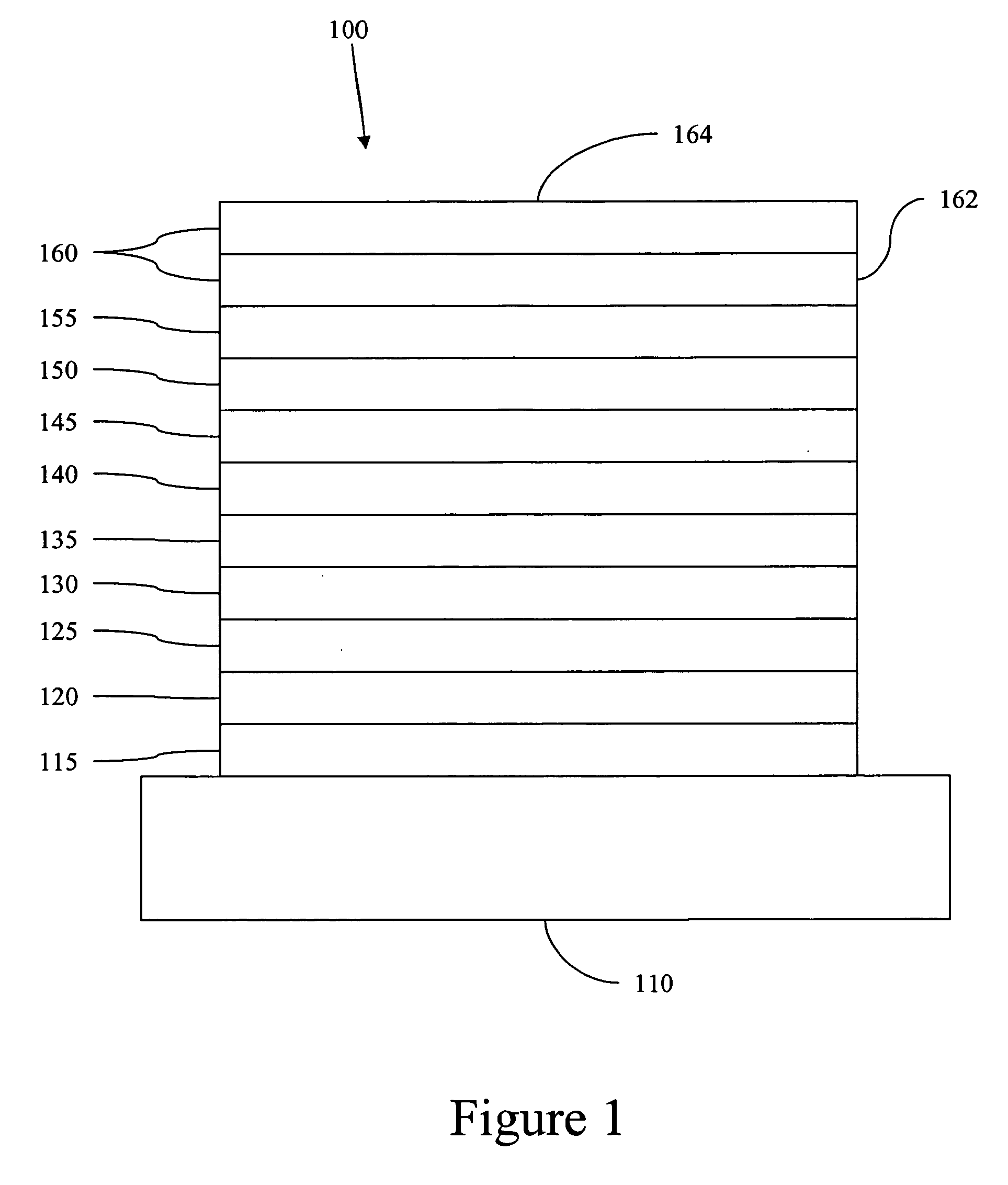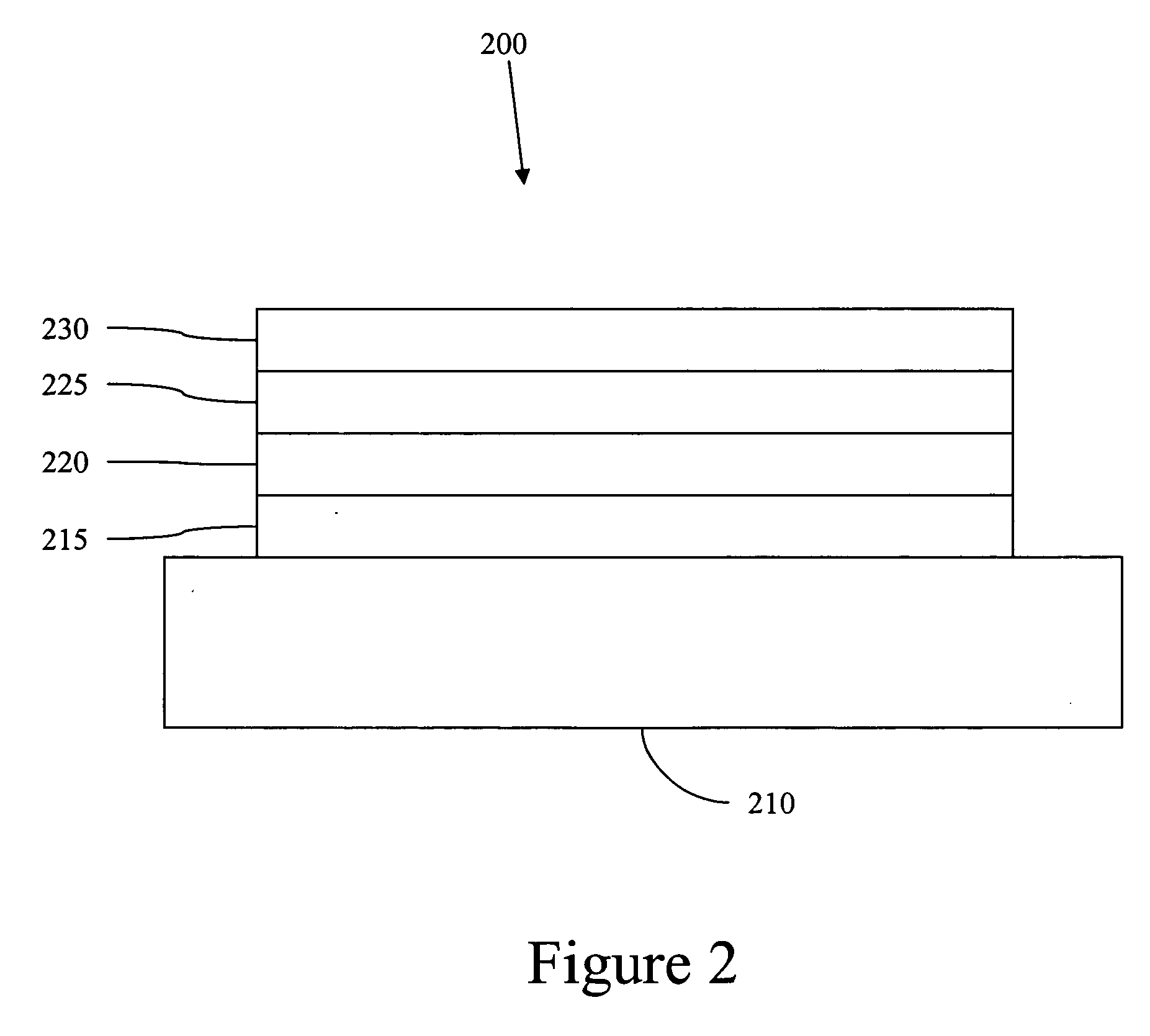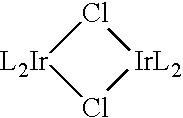Carbene containing metal complexes as OLEDs
a carbene and metal complex technology, applied in the direction of indium organic compounds, discharge tube luminescnet screens, organic chemistry, etc., can solve the problems of not being sufficiently stable for commercial devices, not well known applications of carbene ligands in photochemistry, and existing compounds not including compounds that are stable emitters. , to achieve the effect of stable manner
- Summary
- Abstract
- Description
- Claims
- Application Information
AI Technical Summary
Benefits of technology
Problems solved by technology
Method used
Image
Examples
example 1
Synthesis of Fac-Iridium(III) Tris (1-(2-Naphthyl-3-Methyl-Benzimidazoline-2-Ylidene-C,C2) and Mer-Iridium(III) Tris (1-(2-Naphthyl-3-Methyl-Benzimidazoline-2-Ylidene-C,C2)
[0122] A 3 L round-bottomed flask was charged with 113.83 g of silver(I) oxide, 38 g of 1-(2-naphthyl)-3-methyl-benzimidazolate iodide, 9.1 g of iridium trichloride hydrate, and 2000 mL of 2-ethoxyethanol. The reaction was stirred and heated at 120° C. for 2 hours under nitrogen while protected from light with aluminum foil. The reaction mixture was cooled to ambient temperature and concentrated under reduced pressure(20 mmHg). Filtration through Celite using dichloromethane as the eluent was performed to remove the silver(I) salts. A light brown solution was obtained and further purified by flash column chromatography on silica gel using dichloromethane as the eluent yielding 6 g (25.2%) of fac-iridium(III) tris (1-(2-naphthyl-3-methyl-benzimidazoline-2-ylidene-C,C2). The mer isomer was selectively crystallized...
example 2
Synthesis of Iridium (III) Bis(1-Phenyl-3-Methyl-Imidazoline-2-Ylidene-C,C2) Chloride Dimer
[0123] A 2 L round-bottomed flask was charged with 80.87 g of silver(I) oxide, 10 g of 1-phenyl-3-methyl-imidazolate iodide and 1 L of dichloromethane. The reaction was stirred at room temperature for 15 h under nitrogen while protected from light with aluminum foil. The reaction mixture was concentrated under reduced pressure. Filtration through Celite using dichloromethane as the eluent was performed to remove the silver(I) salts. The filtrate was concentrated to dryness and transferred to a 2 L round-bottomed flask by re-dissolving it in 2-(2-methoxyethoxy)ethanol (1000 mL). The reaction was stirred and heated to 185° C. under nitrogen. Iridium(III) trichloride hydrate (6.47 g) was added to the reaction mixture while the reaction temperature was maintained at 185° C. The reaction mixture was stirred and heated for a further 5 hours at 185° C. The reaction mixture was cooled to ambient tem...
example 3
Synthesis of Fac-Iridium(III) Tris (1-Phenyl-3-Methyl-Benzimidazoline2-Ylidene-C,C2)
[0124] A 100 mL round-bottomed flask was charged with 740 mg of 1-phenyl-3-methyl-benzimidazoline iodide, 500 mg of Iridium(III) benzylpyridine dichloro bridged dimer, 470 mg of sodium carbonate and 100 mL of 2-ethoxyethanol. The reaction was stirred and heated at 135° C. for 3 h under nitrogen while protected from light with aluminum foil. The reaction mixture was cooled to ambient temperature and concentrated under reduced pressure(20 mmHg). A light brown solution was obtained and further purified by flash column chromatography on silica gel using dichloromethane as the eluent yielding 540 mg (75%) of fac-iridium(III) tris(1-phenyl-3-methyl-benzimidazoline-2-ylidene-C,C2).
PUM
| Property | Measurement | Unit |
|---|---|---|
| temperature | aaaaa | aaaaa |
| time | aaaaa | aaaaa |
| time | aaaaa | aaaaa |
Abstract
Description
Claims
Application Information
 Login to View More
Login to View More - R&D
- Intellectual Property
- Life Sciences
- Materials
- Tech Scout
- Unparalleled Data Quality
- Higher Quality Content
- 60% Fewer Hallucinations
Browse by: Latest US Patents, China's latest patents, Technical Efficacy Thesaurus, Application Domain, Technology Topic, Popular Technical Reports.
© 2025 PatSnap. All rights reserved.Legal|Privacy policy|Modern Slavery Act Transparency Statement|Sitemap|About US| Contact US: help@patsnap.com



